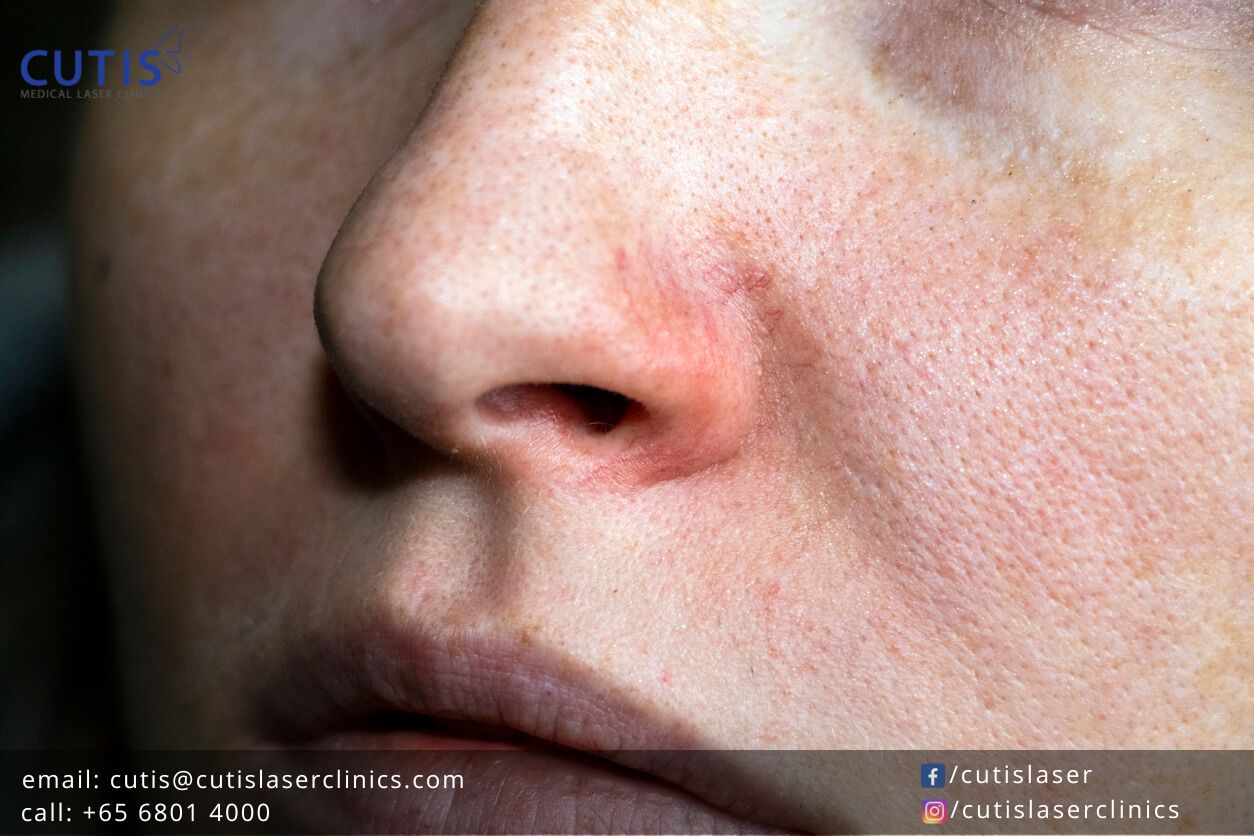
Spider veins don’t just appear on legs. These clusters of red, blue, or purple veins (that look like a spider’s web) can also be visible on the face. And while they are typically not harmful or painful, spider veins are considered unsightly and can make the skin look red or flushed.
What exactly are spider veins?
Also referred to as broken blood vessels and telangiectasias, spider veins on the face appear when the capillaries on your skin are dilated or enlarged. They usually appear as thin and small veins that look like spiderwebs or tree branches on the face. Telangiectasias commonly occur on the nose, cheeks, and chin.
The most prominent symptoms of spider veins are their appearance, which can be highly noticeable in some cases. They typically don’t hurt, but others may experience some itching or mild discomfort in the area. Many wish to improve or get rid of their spider veins due to cosmetic reasons or how they look.
What causes spider veins on the face?
Both men and women can have spider veins on the face, but women are more often affected. Some people, on the other hand, tend to develop telangiectasias more than others. Below are the causes of broken blood vessels.
- Genetics – Having a family history of spider veins increases your risk of developing them.
- Sun damage – Ultraviolet (UV) rays from the sun can damage the skin and cause spider veins or broken blood vessels, particularly on the face.
- Rosacea – This chronic skin inflammatory condition causes persistent facial blushing due to broken blood vessels. It is also common for people with rosacea to have telangiectasias or spider veins.
- Pregnancy – Broken blood vessels can become visible due to hormonal changes during pregnancy. These usually disappear after giving birth.
- Weather changes – In hot weather, the veins under the skin enlarge or dilate. Hot summer days can also cause skin redness.
- Alcohol consumption – Alcohol can cause the blood vessels to dilate temporarily. Frequent and heavy consumption of alcohol may lead to lasting redness and broken blood vessels on the face.
- Injuries – Some injuries can cause bruising. If you have bruising on your face, spider veins may also be noticeable.
- Pressure in the face – Intense sneezing or vomiting can cause extreme pressure on the face. This can break the blood vessels in the skin, resulting in the appearance of spider veins.
How can you treat or get rid of spider veins on the face?
No topical product can sufficiently treat or get rid of spider veins. If you’re looking for an effective solution, it is advisable to see a skin or aesthetic doctor. At Cutis Medical Laser Clinics, we have the Cutera® Laser Vein Reduction, which uses pulses of light energy to treat spider veins on the face and other areas of the body.
The procedure is completely non-invasive, so there’s no need to worry about scarring. The laser energy does the work by causing the blood within the vein to coagulate. This then destroys the vein, which is later reabsorbed by the skin. The blood flow is redirected to the veins deeper below the skin surface, where it’s supposed to be.
Results can be seen within two to six weeks, depending on the size, color, and the number of veins to be treated. Touch-up treatments are recommended to maintain the results or if new veins appear. There may be some stinging sensation from the light pulses, but a topical anesthetic is given before the treatment to improve patient comfort.
Aside from the Cutera® Laser Vein Reduction, we have two other non-invasive procedures that can help treat or improve broken blood vessels and facial redness.
Laser Genesis – heats the upper dermis well below the skin surface to stimulate collagen production. It also generates extra heat in dilated capillaries to minimize facial redness. Laser Genesis can also improve other skin conditions, including enlarged pores, broken blood vessels, sun damage, pigmentation, and fine lines and wrinkles.
Limelight Photo Facial – uses intense pulsed light (IPL) to target pigmentation and stimulate collagen production. It can also reduce blood flow to the broken capillaries to reduce tiny veins and diffuse facial redness. It can improve several skin issues, such as brown spots, sun damage, facial redness/veins, and fine lines and wrinkles.
Can you prevent spider veins on the face?
For visible spider veins and facial redness, you need to see a skin or aesthetic doctor to treat them. And while undergoing treatment, some preventative measures can prevent the occurrence of future telangiectasias.
Limit or avoid sun exposure – This is especially true when UV rays are the strongest, between 10 am and 4 pm. Make sure to wear a broad-spectrum sunscreen when going out and accessorize with a brimmed hat and sunglasses.
Avoid extreme heat – High temperatures from spas, saunas, and hot weather may cause your blood vessels to dilate and make your spider veins appear more visible.
Wear protective gear – To avoid or reduce injuries, bruising, and spider veins, wear a helmet and other face gear when cycling or participating in sports.
Drink in moderation – Too much alcohol consumption can lead to facial redness and telangiectasias. Be sure to only drink occasionally or ask your doctor if you need help in quitting.
If the spider veins on your face are making you self-conscious, take measures to treat them and see a professional. Contact Cutis Medical Laser Clinics in Singapore today and schedule a consultation with our aesthetic doctor to learn more about our vein reduction treatments or find out which one is right for you.
- If you would like to be an informed patient, please contact us at +65-6801-4000 or
hello@cutislaserclinics.com. - Cutis Medical Laser Clinics, 9 Scotts Road Pacific Plaza, Scotts Medical Center #08-07, Singapore – 228210
+65-6801-4000 - hello@cutislaserclinics.com
